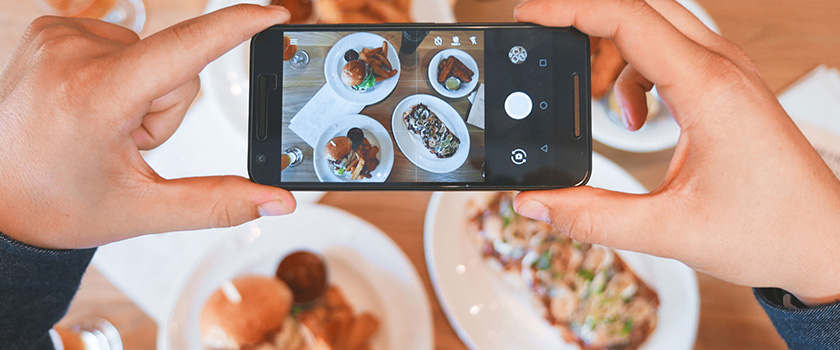addmustard’s got a new string to its bow: training budgets. We’ve always had the option of going on training courses, but it fell by the wayside if we’re honest. So when individual training budgets were allocated in our company update, which included lots of exciting new mustard perks (hello, flexi-time), there were murmurs of interest.
So, as the skipper of the addmustard social feeds, last week my training budget and I trundled off to two Social Media training courses. Day 1 was a Guardian Masterclass on Social for Business, hosted by Ed Goodman of SocialB. He took us through the nitty gritty of setting up reports, and the importance of goals, before opening a discussion on the wider aspect of social media, it’s purposes, and our aims.
Day 2 found me with Kerry Watkins, of Social Brighton, exploring the realms of Social Strategy. This was the grounding to the wider thinking of the day before. We went through building a strategy, finding your audience, setting up paid ads, and monitoring via Google Analytics.
I returned with our brand new strategy clutched in my hands, and a mind whirling with new ideas and themes. On the train back to Brighton, I tweeted a photo of the class at the event, and the impressions and engagement it received far outweighed that of our previous tweets. I felt like I’d been given a magic key.
A brilliant day's training had by all at #SocialMediaGMC with @edagoodman and @guardianclasses 👌🏻 pic.twitter.com/vqYdgjTctW
— addmustard (@add_mustard) June 7, 2017
Of course, there is no magic key to Social Media. It’s creative, subjective, and colourful. But don’t get me wrong, that’s not to say it’s not measurable. And that’s one of the key things I learnt over my two days of training.
If I had to sum up my key learnings, I’d say:
- Reporting – without it, how can we hope to improve?
- Just because social is creative, it doesn’t mean we can’t prove its value.
- Social is sociable. To reap the benefits, we must be human, and be kind.

Reporting and Social Media
This was, for me, the most important lesson I took away with me. Reports are often pushed into the ‘too difficult’ pile by those in creative roles: “I’m a wordsmith, not a number-cruncher!”
But in reality, if we’re not reporting on what we’re doing, how can we hope to improve? Reporting on what works and what doesn’t (and there will be plenty of both!) is crucial.
Since the classes, I’ve set up a monthly report, containing figures for impressions, followers, reach, and crucially, engagement, over all of our social platforms. It’s not pretty or complex, but it allows me to record everything I need.
Already I can see themes emerging from what generally does well, and what doesn’t. And that’s allowing me to learn from past posts, and importantly, to improve for future ones.

Proving the value of Social Media
The second lesson I learned was that you can prove the value of Social Media. Being relatively new to it, I’ve already had a lot of people warning me how difficult it is to prove social’s worth.
Nonsense, I say to that!
Sure, historically it was tricky. But today, with all the tools, analytics, and measurement we have at our fingertips, we can see exactly how well each post does. We can see how social affects our web traffic, what pages readers visit, and where they go after that. We have attribution models that allow us to incorporate social clicks, and lastly, we’re fools if we overlook the value of brand awareness.
I also think we Social Media marketers are the luckiest in the industry. We have unbounded audiences! In SEO, Content, and Design, we have to guide our audience to the (relevant and high quality, of course) web pages we want them to see. With social, by using something as simple as targeted hashtags, we can jump into conversations, bring our brand’s personality into perspective, and connect with brand new people every day.
And that’s marvellous.

Staying sociable and being kind
Stay with me for this one – I won’t get fluffy, I promise. I just want to say something that will sound blindingly obvious.
Social Media is sociable.
I think that’s very often overlooked. Our audiences aren’t on Twitter to be sold to. They don’t want to be stalked around Facebook, or bombarded with USPs on Instagram. No. They’re there to socialise. To read stories, to daydream, to be inspired, and to relax.
That’s why, whenever I post as addmustard, I’m fundamentally human. I try to post as I would as Alice: naturally.
I don’t try to cram in keywords and irrelevant hashtags. I try not to hound people and force relationships. And if I see an interesting piece of content, I’ll give it a share or a like without expecting reciprocation.
And that’s where being kind comes in.
Those who simply post, post, post won’t ever ‘succeed’ at social. They’re not engaging with the conversation, or contributing anything of interest. What’s the point if we’re not adding value?
Our audiences are clever, and they’re tired of brands treating them like they’re silly. They’re just as human as those behind brands’ social feeds. So if we just take the time to browse our platforms, give a retweet here and a like there, and perhaps message him or her, we’ll be far closer to presenting the natural personality of our brand than any USP post will.
Why is the Innocent Twitter feed so stunningly popular? Because of its humanity. A smoothie company tweeting about the weather, or the latest TV programme sounds bizarre. But it works.
Both the training days were brilliant, and I came away with a fresh sense of purpose and enthusiasm. Since then, we’ve already been seeing the benefits. Our engagement and reach is up. Our reports are running, and we’ve a shiny new social strategy and policy magnum. We’re putting budget behind posts that we’d like more eyes on, and we’re reaching out to the wonderful Brighton community that we live and breathe.
I’d like to say a huge thank you to both Ed and Kerry. They’re wonderful trainers, and I definitely recommend their courses.


